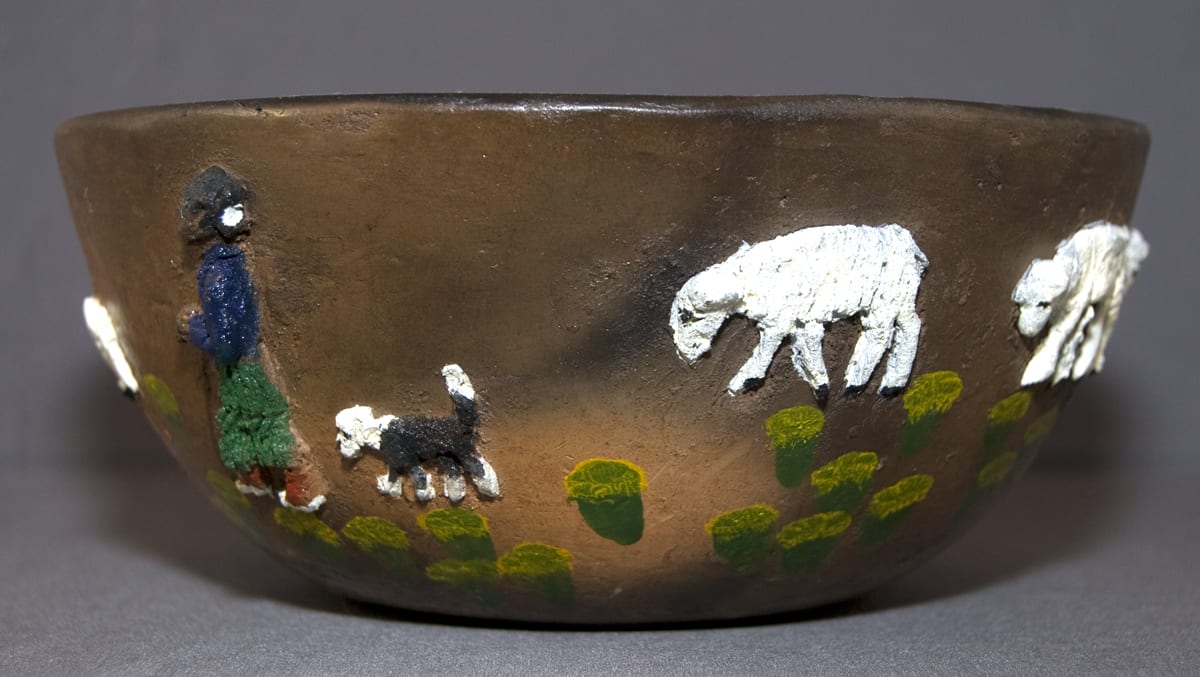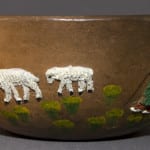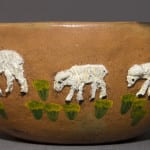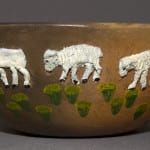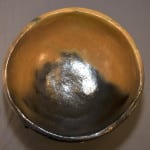This bowl has nine sheep wandering around its exterior surface, followed by a shepherd and her dog. They are finely detailed and deeply incised, giving them depth; each is slightly different, giving them an appealing character. After the figures were formed and the pot fired, the figures were painted with acrylic paints and 41 sagebrush images and a shepherd’s staff were painted on the surface of the bowl. Signed “S Claw,” the bowl was formed by Bertha Claw and the appliqué was formed and painted by her husband Silas. After being fired and painted, the pot was coated with marine varnish in place of the traditional pinion pitch. Such varnish was readily obtainable and has the advantage of not puddling and obscuring the details of the appliqué (Dobbins and Russell, 2007:59). The bowl was made during the last five years of Silas’ life, probably in late 1996 or early 1997.
Given their nomadic past, pottery only became a tribal craft when the Navajo settled in the Southwest in the 1500’s. With the arrival of trains and manufactured containers in the 1870’s, the craft began to fade away, being made then primarily for ceremonial use. The Shonto/Cow Springs area of the Navajo reservation remained the center of Navajo pottery production. Clay is plentiful, there was a critical mass of older potters to teach girls to pot, and the area is particularly remote, thus closing off other options for female employment. When roads and Glen Canyon Dam were built in the 1960’s, tourist traffic increased, creating a market.
In the 1940s an Anglo trader, Bill Beaver worked at Shonto Trading post and began to seek out local potters. Later he owned Sacred Mountain Trading post north of Flagstaff. I visited the trading post (now closed) over the years and was generally overwhelmed by the hundreds of Navajo pots Beaver had for sale. Beaver and other Anglo traders promoted Navajo pottery and Navajo clay entered the southwestern crafts market in the 1960’s (Dobbins and Russell, 2007:58).
The pottery career of the Claws is extensively documented (Dobbins and Russell, 2007: 56-65; Rosenak, 1994:122-123; Hartman and Musial, 1987: 56-58; and Wright and Bell, 1987: 28 &31).
Silas was born at the end of 1913; Birtha in 1926. Silas passed away in 2002. The sheep motif on 2011-01 is not accidental; it’s what Bertha and Silas spent much of their days doing on Bertha’s land near Cow Springs, Arizona. As a young man Silas worked as migrant labor, joined the CCC and later worked as part of a railroad repair crew. Bertha worked in the home (Dobbins and Russell, 2007:57). Starting in 1968, Silas was one of the first Navajo men to work with clay.
By 1970 the Claws began to add figural depictions of corn and plants to their pots to attract Anglo buyers. (See 1991-08 for a pot with corn appliqué by Aleta Biysi that I bought at Shonto Trading Post in May, 1991.) By 1985 the Claws were producing 100 to 150 pots a year. After 1985 they were able to get electricity to their home and Silas stopped working for wages and concentrated on decorating pottery (in addition to herding sheep). From this time until Silas’ death 17 years later the couple produced about 200 pots a year, much of it with painted appliqué. Silas molded a wide variety of figures, from sheep and Ye’ii to bunny rabbits and Pocahontas. As Silas’ vision weakened, nieces Ella Shortman and Daisy Tate helped paint the pottery and detailed some of the appliqué. It was during this period that Silas began to consistently sign his work. Only his signature appears on a pot, but “S. Claw” pottery is a team effort: Bertha formed the pots and Silas provided the decoration. Bertha never signed the pots. Most pottery was dried on top of the couple’s wood burning stove and then fired for 30 minutes to an hour inside the stove. Because of the heat generated by the stove, the Claws preferred to fire their pottery during cooler weather (Dobbins and Russell, 2007:59-61).
For a photographs of the Claws (most taken in the 1980s) see Dobbins and Russell, 2007: 60; Rosenak, 1994:122 ; Hartman and Musial, 1987:58; and Wright and Bell, 1987: 28 &31). Dobbins & Russell and Wright & Bell show the same photograph, though it’s somewhat larger in the latter publication.

